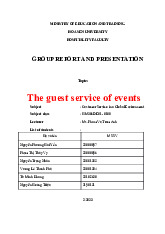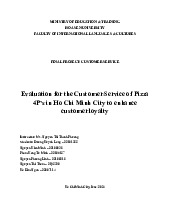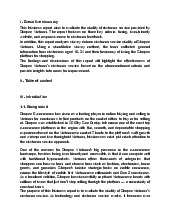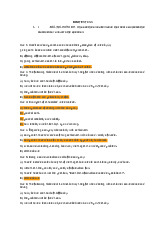













Preview text:
Sunsilk Shampoo Introduction:
Sunsilk is a global hair care brand with a strong presence in over 80 countries. It
targets women and focuses on female empowerment and self-expression through hair
care. This creates a connection with consumers, allowing Sunsilk to be a good case
study for understanding consumer behavior.
By choosing Sunsilk as the subject of our research paper, we can gain valuable
insights into consumer behavior in the hair care industry and contribute to the
understanding of global consumer trends.
Problems: Young females are a demographic particularly susceptible to damaged hair
● Attributed to a variety of styling practices
● The damage can not only affect the health of the hair, but can also lead to a decrease in self-confidence.
● New hairstyles can damage hair, so special care is needed to protect hair from
coloring, bleaching, and heat styling.
Needs : Modern women are placing a greater emphasis on
● Personal grooming and self-care, recognizing the importance of a healthy and attractive appearance.
Sunsilk offers wide range of hair care for various needs, focused on natural
ingredients, empowers women to embrace their hair and chase their dreams
Our group objectives in this report: -
Collect and analyze data to develop a data-driven marketing plan. -
Gain a deeper understanding of target customer. -
Have the skills to conduct a survey
I. Conduct research to understand your target customers, including:
a. Managing the customer behavior (buying, having, being)
● The study of the processes involved when individuals or groups select, purchase, use,
or dispose of products, services, ideas, or experiences to satisfy needs and desires.
● The needs and desires we satisfy range from hunger and thirst to love, status, and even spiritual fulfillment.
This framework focuses on the entire customer journey, encompassing the three stages:
● Buying: Understanding what triggers a customer's need, how they research options,
and what influences their purchase decision (price, brand, etc.).
● Having: Focusing on the customer's experience with the product or service. Includes
factors like quality, customer service, and ease of use.
● Being: Exploring how owning or using the product makes them feel about themselves.
The statement: “I'm looking into different shampoos and conditioners of Sunsilk to find
one that might help with hair loss” has received the most positive responses with 37
upvotes. The statement reveals several aspects of customer behavior related to Sunsilk
shampoo and conditioner. The customer is aware of a hair loss issue and is actively seeking a
solution. Sunsilk is a brand they're considering for solving their hair loss problem. This
indicates brand awareness and potentially past positive experiences or brand trust.
b. Managing factors influence on customer behavior
Delves deeper into the "why" behind customer behavior. It explores the internal and external
factors that shape how customers make decisions:
● Internal Factors: Personal aspects like needs, motivations, attitudes, and past experiences.
● External Factors: Social influences, economic conditions, marketing strategies, etc.
The data shows that external factors play a significant role in consumer awareness of
the Sunsilk brand. A large portion of consumers recognize the brand through TV ads,
Online advertisement and social media. Additionally, internal factors, such as hair
condition, also significantly impact customer behavior. According to the survey, most
people describe their hair condition as oily, damaged and dry.
c. Managing motivation and effect on customer behavior
Motivation is a key internal factor influencing customer behavior. It refers to the
driving force behind a customer's needs and desires. Effectively managing motivation involves:
● Identifying customer motivations: Understanding what motivates customers
to buy your product or service (e.g., solve a problem, achieve a goal, feel good).
● Shaping customer perceptions: Craft messaging that highlights how your
product satisfies those motivations.
● Creating a positive experience: Deliver on your promises to maintain
customer satisfaction and loyalty.
The number of consumers who think of Sunsilk first when it comes to shampoo
highlights the brand's strong competitive edge and brand recognition compared to other brands. The statements:
“Since using Sunsilk, my hair has noticeably improved in health and appearance” with
most answers: Agree (33)
“Sunsilk offers a variety of hair care solutions that address my specific hair needs”
with most answers: Agree (34)
“The fragrance and experience of using Sunsilk make it enjoyable to incorporate into
my hair care routine” with most answer: Agree (35)
Data indicates that Sunsilk provides a positive consumer experience, not only due to
its product quality but also its pleasant fragrance.
d. Understanding customer’s personality, lifestyles and values
Understanding your customer's personality, lifestyles, and values is a powerful tool in any marketer's toolbox.
● Personality: This refers to a person's characteristic traits. Understanding these traits
can help you tailor your messaging to resonate with their natural preferences.
● Lifestyle: This encompasses how people live their day-to-day lives. By understanding
their lifestyle, you can see how your product or service fits into their routine.
● Values: These are the core principles that guide a person's decisions. Aligning your
brand with their values creates a deeper connection.
Understanding cultural aspects is also an effective way to tailor product design to different
cultures. In this case, all three survey questions received higher levels of agree and strongly
agree compared to the other responses, indicating that Sunsilk has produced products that
meet the criteria of Vietnamese consumers
e. Understanding customer’s attitudes and persuasive communications
Understanding Customer Attitudes
A customer's attitude is their overall evaluation of a product, service, brand, or even a
shopping experience. It's a combination of three things:
● Thoughts (cognitive): Beliefs and knowledge about the product or service.
● Feelings (affective): Emotions associated with the product or service.
● Behaviors (conative): Intention to purchase, use, or recommend the product or service
Data indicates that Sunsilk is a popular choice among consumers seeking shampoos with
specific benefits such as hydration and softening…
Persuasive Communication
● Persuasive communication is the art of crafting messages that influence a customer's
attitude or behavior. The goal is to get them to think, feel, or act in a specific way.
● Addressing their concerns, highlighting the benefits that align with their needs, and
using language that resonates with them, you can nudge them towards a more positive
attitude and ultimately, a desired action
Majority of consumers are highly concerned about product price and quality. This indicates
that Sunsilk should prioritize product quality enhancement and consistently introduce new
product lines with reasonable pricing to cater to a wider range of consumers.
f. Understanding customer’s decision making
Prospective customers engage in a sequential decision-making process before a purchase
occurs. This framework outlines the key stages:
1. Need Recognition: The process begins with the identification of a problem or unfulfilled need.
2. Information Search: In this stage, the customer actively seeks information to
understand available solutions.
3. Evaluation of Alternatives: Having gathered information, the customer evaluates
potential solutions. This involves weighing the features and benefits of different
products or services against their specific needs and budget.
4. Purchase Decision: Based on the evaluation, the customer makes a final decision to
purchase the chosen solution or potentially delay the purchase altogether.
5. Post-Purchase Evaluation: Following the purchase, the customer assesses their
satisfaction with the chosen solution.
I'm noticing more hair loss than usual lately, and it's starting to worry me Most answers: Agree (36)
I'm looking into different shampoos and conditioners of Sunsilk to find one that might help with hair loss. Agree 38 Most answer:




